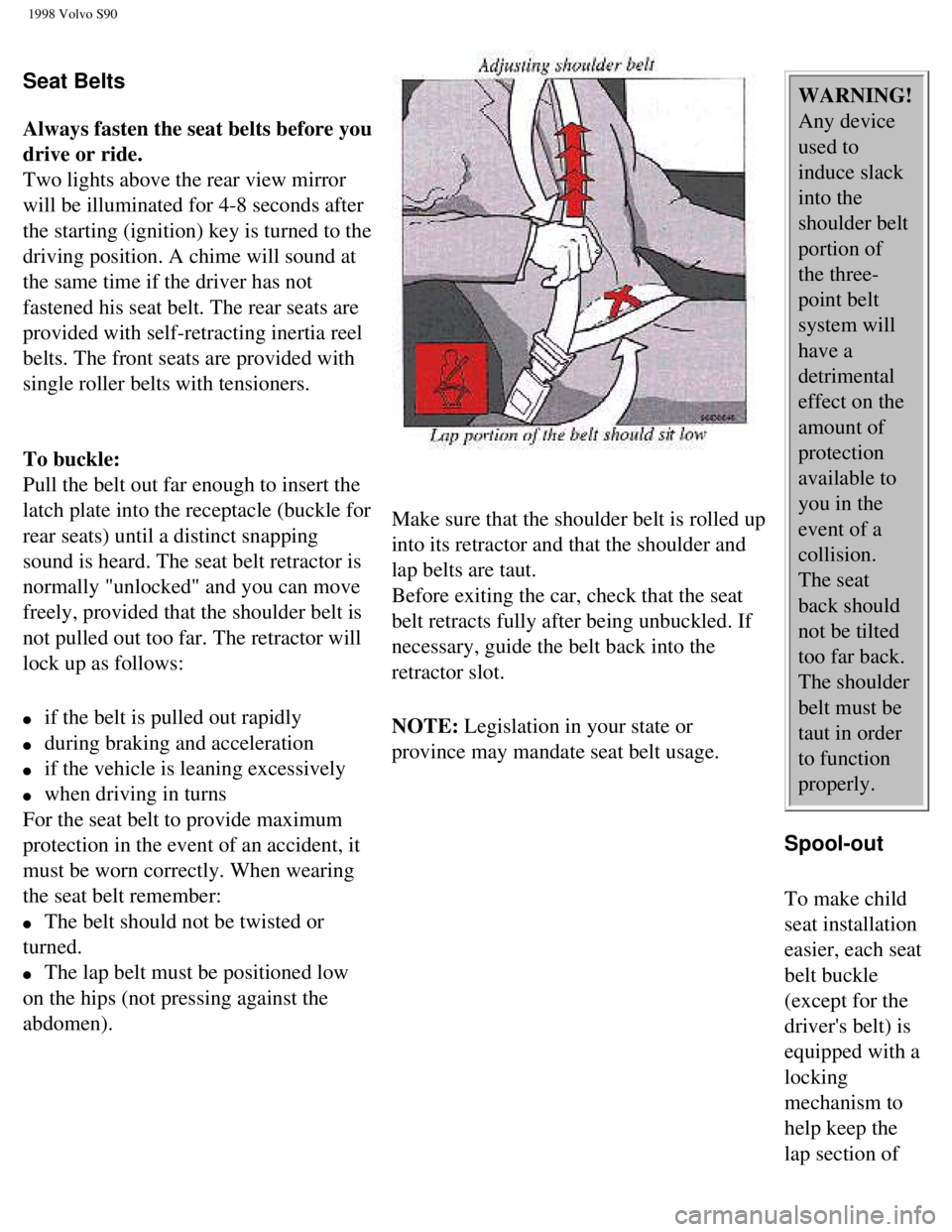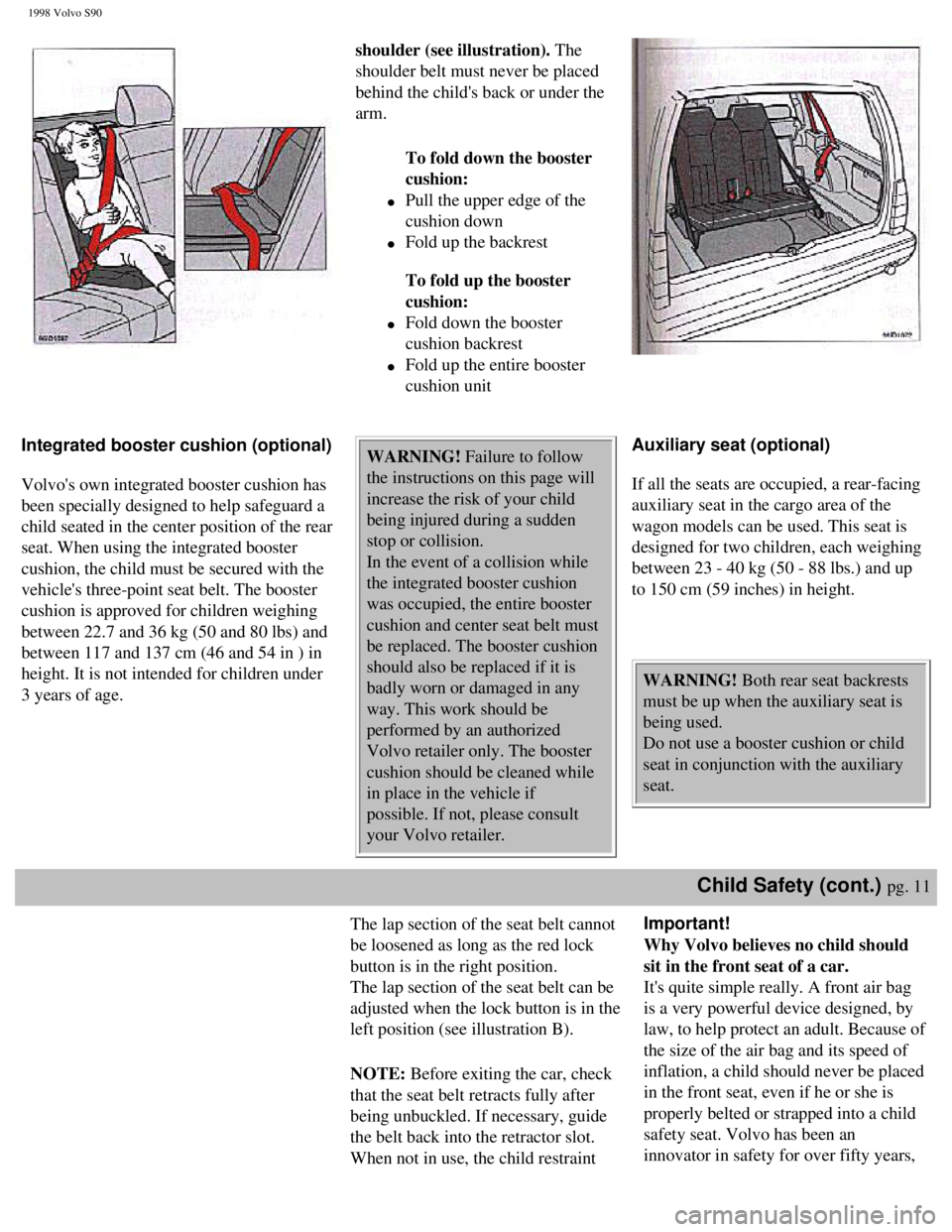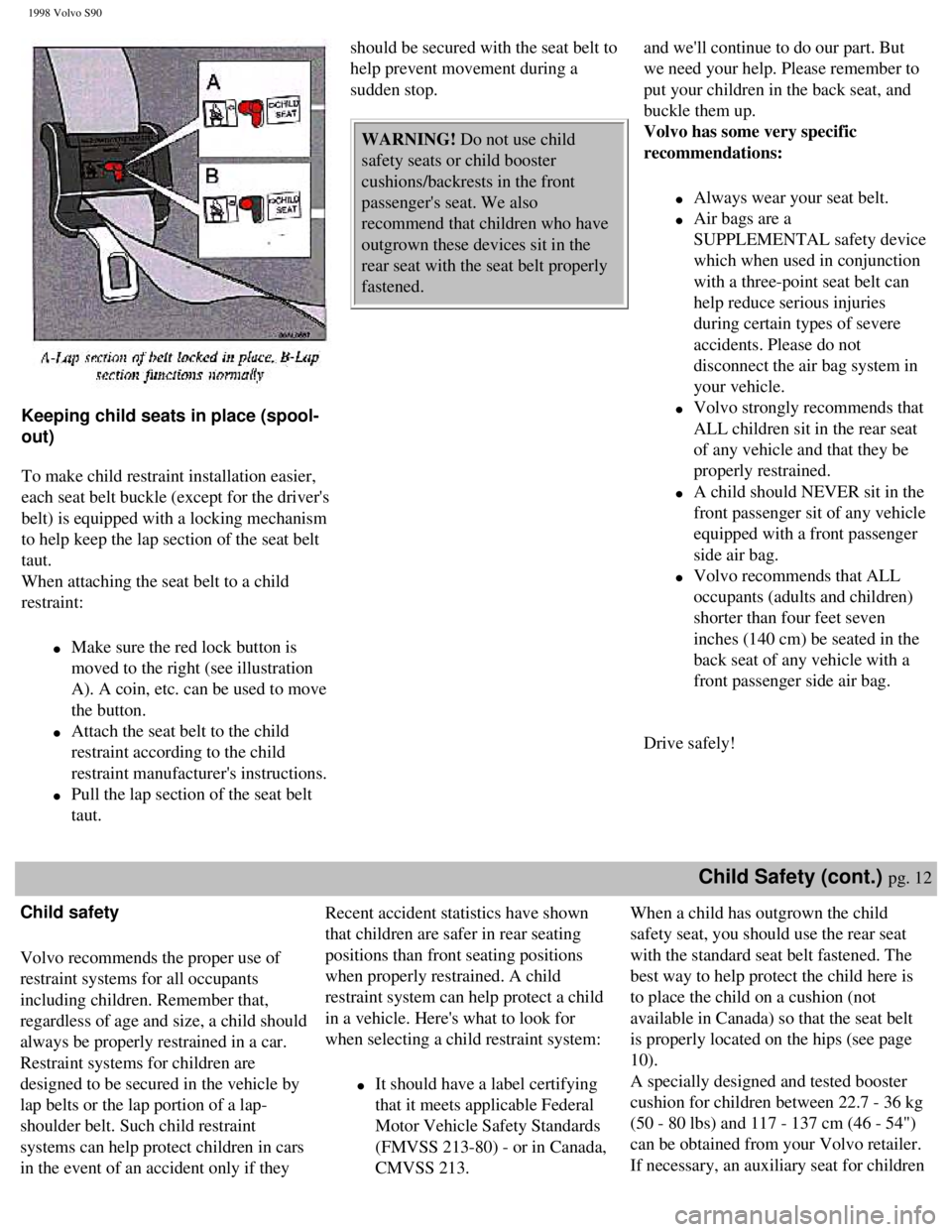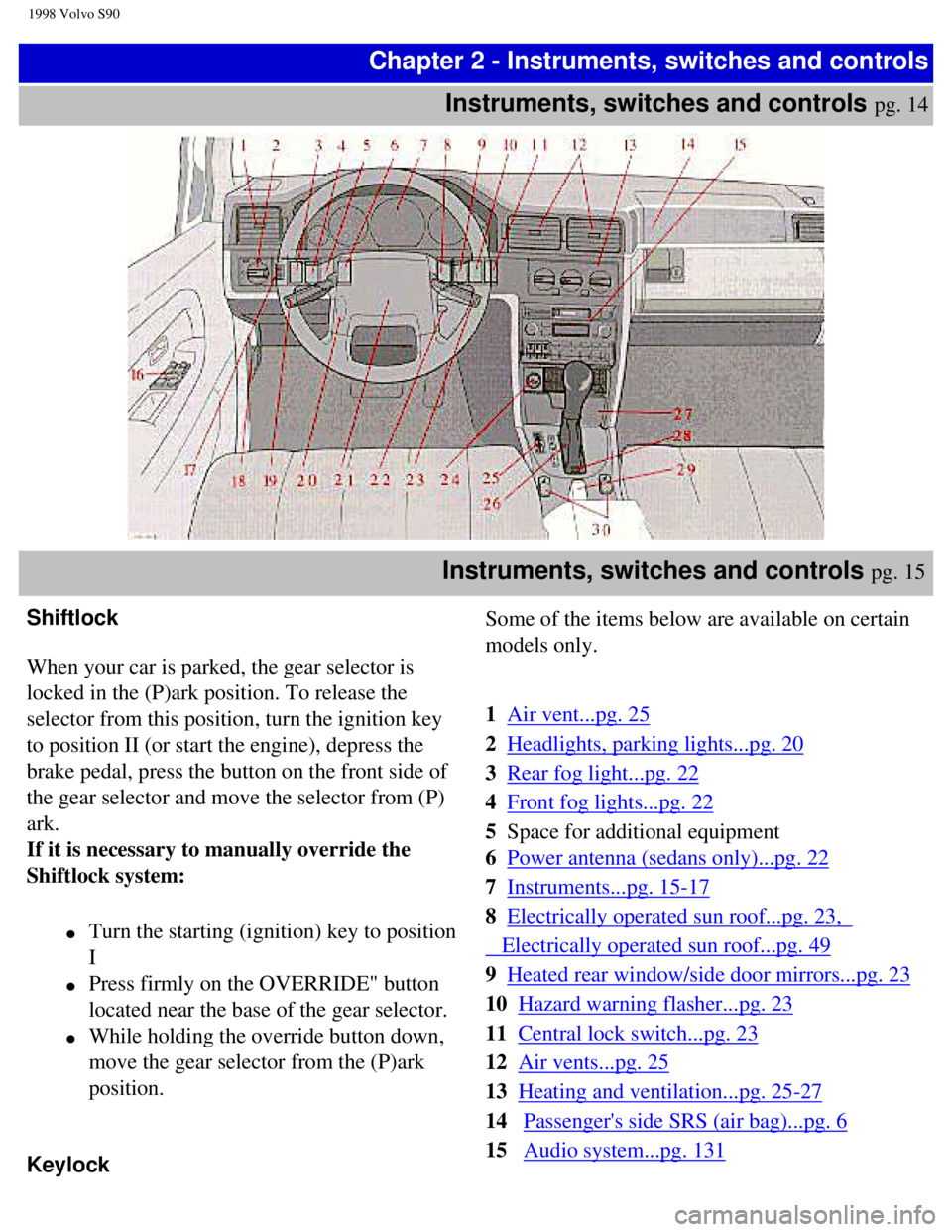1998 VOLVO V90 lock
[x] Cancel search: lockPage 6 of 175

1998 Volvo S90
Seat Belts
Always fasten the seat belts before you
drive or ride.
Two lights above the rear view mirror
will be illuminated for 4-8 seconds after
the starting (ignition) key is turned to the
driving position. A chime will sound at
the same time if the driver has not
fastened his seat belt. The rear seats are
provided with self-retracting inertia reel
belts. The front seats are provided with
single roller belts with tensioners.
To buckle:
Pull the belt out far enough to insert the
latch plate into the receptacle (buckle for
rear seats) until a distinct snapping
sound is heard. The seat belt retractor is
normally "unlocked" and you can move
freely, provided that the shoulder belt is
not pulled out too far. The retractor will
lock up as follows:
l if the belt is pulled out rapidly
l during braking and acceleration
l if the vehicle is leaning excessively
l when driving in turns
For the seat belt to provide maximum
protection in the event of an accident, it
must be worn correctly. When wearing
the seat belt remember:
l The belt should not be twisted or
turned.
l The lap belt must be positioned low
on the hips (not pressing against the
abdomen).
Make sure that the shoulder belt is rolled up
into its retractor and that the shoulder and
lap belts are taut.
Before exiting the car, check that the seat
belt retracts fully after being unbuckled. If
necessary, guide the belt back into the
retractor slot.
NOTE: Legislation in your state or
province may mandate seat belt usage.
WARNING!
Any device
used to
induce slack
into the
shoulder belt
portion of
the three-
point belt
system will
have a
detrimental
effect on the
amount of
protection
available to
you in the
event of a
collision.
The seat
back should
not be tilted
too far back.
The shoulder
belt must be
taut in order
to function
properly.
Spool-out
To make child
seat installation
easier, each seat
belt buckle
(except for the
driver's belt) is
equipped with a
locking
mechanism to
help keep the
lap section of
file:///K|/ownersdocs/1998/1998_SV90/98S90_001.htm (2 of 5)12/30/2006 \
1:52:33 PM
Page 13 of 175

1998 Volvo S90
characteristic and does not
indicate fire. area above the glove
compartment) or the area
affected by air bag
deployment (see
illustration).
l There should be no loose
articles, e.g. coffee cups,
on the floor, seat or dash
area.
l Never try to open the
SRS cover on the steering
wheel or the passenger
side SRS hatch. This
should only be done by
an authorized Volvo
service technician.
l Failure to follow these
instructions can result in
injury to the vehicle
occupants in an accident.
VOLVO SRS (cont.) pg. 7
NOTE:The information on this page does not pertain
to the Side Impact Protection System airbags.
When are the airbags deployed?
The SRS system is designed to deploy during certain
frontal or front-angular collisions, impacts, or
decelerations, depending in the crash severity, angle,
speed, and object impacted. The SRS sensor is
designed to react to both the impact of the collision
and the inertial forces generated by it and to
determine if the intensity of the collision is sufficient
for the airbags to be deployed.
WARNING! The SRS is designed to help prevent
serious injury. Deployment occurs very quickly
and with considerable force. During normal
deployment and depending on variables such as
seating position, one may experience abrasions,
bruises, swellings, or other injuries as a result of
airbag(s) deployment.
Seat belts - the heart of the Volvo safety
system
The heart of the Volvo safety system is the three-
point seat belt (a Volvo invention)! In order for the
SRS system to provide the protection intended, seat
belts must be worn at all times by everyone in the car.
The SRS system is a supplement to the seat belts.
WARNING! If your car has been subjected to
flood conditions (e.g. soaked carpeting/standing
water on the floor of the vehicle) or if your car has
become flood-damaged in any way, do not
attempt to start the vehicle or put the key in the
ignition before disconnecting the battery (see
below). This may cause airbag deployment which
could result in personal injury. Have the car towed
to an authorized Volvo retailer for repairs.
Automatic transmission only:
Before attempting to tow the car, use the
following procedure to override the shiftlock
file:///K|/ownersdocs/1998/1998_SV90/98S90_004.htm (4 of 7)12/30/2006 \
1:52:34 PM
Page 14 of 175

1998 Volvo S90
If the airbags have been deployed, we recommend
the following:
l Have the car towed to an authorized Volvo
retailer. Never drive with the airbags
deployed.
l Have an authorized Volvo retailer replace the
SRS system components.
l Use only new, Genuine Volvo Parts when
replacing SRS components (airbags, seat
belts, tensioners, etc.).
When are the airbags NOT deployed?
Not all frontal collisions activate the SRS system. If
the collision involves a non-rigid object (e.g., a snow
drift or bush), or a rigid, fixed object at a low speed,
the SRS system will not necessarily deploy. Airbags
do not normally deploy in a side impact collision, in
a collision from the rear or in a rollover situation.
The amount of damage to the bodywork does not
reliably indicate if the airbags should have deployed
or not.
system to move the gear selector to the neutral
position.
l Disconnect the battery
l Wait at least one minute
l Insert the key in the ignition and turn it to
position 1
l Press firmly on the shiftlock override
button (located near the base of the gear
selector).
l While holding the override button down,
move the gear selector from the park
position.
WARNING! Never drive with the airbags
deployed. The fact that they hang out can impair
the steering of your car. Other safety systems can
also be damaged. The smoke and dust formed
when the airbags are deployed can cause skin and
eye irritation in the event of prolonged exposure.
Volvo Side Impact Protection System (SIPS) airbag pg. 8
WARNING!
l The SIPS airbag
system is a
supplement to the
Side Impact
Protection System
and the three-point
seat belt system. It
is not designed to
deploy during
collisions from the
front or rear of the
car or in rollover
situations.
l Only Volvo
approved seat
1- Airbag, 2 - cable, 3 - sensor
unit, 4 - gas generator
file:///K|/ownersdocs/1998/1998_SV90/98S90_004.htm (5 of 7)12/30/2006 \
1:52:34 PM
Page 17 of 175

1998 Volvo S90
Chapter 1 - (cont.)Child Safety
pg. 9
Child Restraint Anchorages
Volvo cars are fitted with Child
Restraint Top Tether Anchorages in the
rear seat. There are three anchorages
under the rear section of the car's rear
window shelf on sedans and on the back
rest on wagons. The backrest on wagons
must be folded down slightly to reach
the anchorages. When the car is
delivered, the holes for these anchorages
are covered by plastic covers. In cars
designated for Canada, one top tether
anchorage set will be in the glove box.
The top tether anchorage set includes the
top tether anchorage plate, an 5/16"
UNC bolt and a plastic trim cover. If
another set is needed, consult your
Volvo retailer. Installing the top tether
Remove the plastic cover on the
anchorage point you want to use. This
can be done with a suitable coin. The
cover is removed counter-clockwise.
Refer to the child seat manufacturer's
instructions for securing the seat.
WARNING! Child Restraint
Anchorages are designed to withstand
only those loads imposed by correctly
fitted Child Restraints. Under no
circumstances are they to be used for
adult seat belts or harnesses. The
anchorages are not able to withstand
excessive forces on them in the event of
collision if full harness seat belts or
adult seat belts are installed to them. An
adult who uses a belt anchored in a
Child Restraint Anchorage runs a great
risk of suffering severe injuries should
a collision occur. Do not install rear
speakers which would require the
removal of the top tether anchors or
interfere with the proper use of the top
tether strap.
Child Safety (cont.) pg. 10
Sedans/Wagons
With the child properly seated on
the booster cushion (see
illustration), adjust the head
restraint to support the child's head
(see page 3). The hip section of the
three-point seat belt must fit
snugly across the child's hips, not
across the stomach.
The shoulder section of the three-
point seat belt should be
positioned across the chest and
file:///K|/ownersdocs/1998/1998_SV90/98S90_009.htm (1 of 5)12/30/2006 \
1:52:35 PM
Page 18 of 175

1998 Volvo S90
shoulder (see illustration). The
shoulder belt must never be placed
behind the child's back or under the
arm. To fold down the booster
cushion:
l Pull the upper edge of the
cushion down
l Fold up the backrest
To fold up the booster
cushion:
l Fold down the booster
cushion backrest
l Fold up the entire booster
cushion unit
Integrated booster cushion (optional)
Volvo's own integrated booster cushion has
been specially designed to help safeguard a
child seated in the center position of the rear
seat. When using the integrated booster
cushion, the child must be secured with the
vehicle's three-point seat belt. The booster
cushion is approved for children weighing
between 22.7 and 36 kg (50 and 80 lbs) and
between 117 and 137 cm (46 and 54 in ) in
height. It is not intended for children under
3 years of age. WARNING! Failure to follow
the instructions on this page will
increase the risk of your child
being injured during a sudden
stop or collision.
In the event of a collision while
the integrated booster cushion
was occupied, the entire booster
cushion and center seat belt must
be replaced. The booster cushion
should also be replaced if it is
badly worn or damaged in any
way. This work should be
performed by an authorized
Volvo retailer only. The booster
cushion should be cleaned while
in place in the vehicle if
possible. If not, please consult
your Volvo retailer. Auxiliary seat (optional)
If all the seats are occupied, a rear-facing
auxiliary seat in the cargo area of the
wagon models can be used. This seat is
designed for two children, each weighing
between 23 - 40 kg (50 - 88 lbs.) and up
to 150 cm (59 inches) in height.
WARNING! Both rear seat backrests
must be up when the auxiliary seat is
being used.
Do not use a booster cushion or child
seat in conjunction with the auxiliary
seat.
Child Safety (cont.) pg. 11
The lap section of the seat belt cannot
be loosened as long as the red lock
button is in the right position.
The lap section of the seat belt can be
adjusted when the lock button is in the
left position (see illustration B).
NOTE: Before exiting the car, check
that the seat belt retracts fully after
being unbuckled. If necessary, guide
the belt back into the retractor slot.
When not in use, the child restraint Important!
Why Volvo believes no child should
sit in the front seat of a car.
It's quite simple really. A front air bag
is a very powerful device designed, by
law, to help protect an adult. Because of
the size of the air bag and its speed of
inflation, a child should never be placed
in the front seat, even if he or she is
properly belted or strapped into a child
safety seat. Volvo has been an
innovator in safety for over fifty years,
file:///K|/ownersdocs/1998/1998_SV90/98S90_009.htm (2 of 5)12/30/2006 \
1:52:35 PM
Page 19 of 175

1998 Volvo S90
Keeping child seats in place (spool-
out)
To make child restraint installation easier,
each seat belt buckle (except for the driver's
belt) is equipped with a locking mechanism
to help keep the lap section of the seat belt
taut.
When attaching the seat belt to a child
restraint:
l Make sure the red lock button is
moved to the right (see illustration
A). A coin, etc. can be used to move
the button.
l Attach the seat belt to the child
restraint according to the child
restraint manufacturer's instructions.
l Pull the lap section of the seat belt
taut.
should be secured with the seat belt to
help prevent movement during a
sudden stop.
WARNING! Do not use child
safety seats or child booster
cushions/backrests in the front
passenger's seat. We also
recommend that children who have
outgrown these devices sit in the
rear seat with the seat belt properly
fastened. and we'll continue to do our part. But
we need your help. Please remember to
put your children in the back seat, and
buckle them up.
Volvo has some very specific
recommendations:
l Always wear your seat belt.
l Air bags are a
SUPPLEMENTAL safety device
which when used in conjunction
with a three-point seat belt can
help reduce serious injuries
during certain types of severe
accidents. Please do not
disconnect the air bag system in
your vehicle.
l Volvo strongly recommends that
ALL children sit in the rear seat
of any vehicle and that they be
properly restrained.
l A child should NEVER sit in the
front passenger sit of any vehicle
equipped with a front passenger
side air bag.
l Volvo recommends that ALL
occupants (adults and children)
shorter than four feet seven
inches (140 cm) be seated in the
back seat of any vehicle with a
front passenger side air bag.
Drive safely!
Child Safety (cont.) pg. 12
Child safety
Volvo recommends the proper use of
restraint systems for all occupants
including children. Remember that,
regardless of age and size, a child should
always be properly restrained in a car.
Restraint systems for children are
designed to be secured in the vehicle by
lap belts or the lap portion of a lap-
shoulder belt. Such child restraint
systems can help protect children in cars
in the event of an accident only if they
Recent accident statistics have shown
that children are safer in rear seating
positions than front seating positions
when properly restrained. A child
restraint system can help protect a child
in a vehicle. Here's what to look for
when selecting a child restraint system:
l It should have a label certifying
that it meets applicable Federal
Motor Vehicle Safety Standards
(FMVSS 213-80) - or in Canada,
CMVSS 213.
When a child has outgrown the child
safety seat, you should use the rear seat
with the standard seat belt fastened. The
best way to help protect the child here is
to place the child on a cushion (not
available in Canada) so that the seat belt
is properly located on the hips (see page
10).
A specially designed and tested booster
cushion for children between 22.7 - 36 kg
(50 - 80 lbs) and 117 - 137 cm (46 - 54")
can be obtained from your Volvo retailer.
If necessary, an auxiliary seat for children
file:///K|/ownersdocs/1998/1998_SV90/98S90_009.htm (3 of 5)12/30/2006 \
1:52:35 PM
Page 22 of 175

1998 Volvo S90
Chapter 2 - Instruments, switches and controlsInstruments, switches and controls
pg. 14
Instruments, switches and controls pg. 15
Shiftlock
When your car is parked, the gear selector is
locked in the (P)ark position. To release the
selector from this position, turn the ignition key
to position II (or start the engine), depress the
brake pedal, press the button on the front side of
the gear selector and move the selector from (P)
ark.
If it is necessary to manually override the
Shiftlock system:
l Turn the starting (ignition) key to position
I
l Press firmly on the OVERRIDE" button
located near the base of the gear selector.
l While holding the override button down,
move the gear selector from the (P)ark
position.
Keylock
Some of the items below are available on certain
models only.
1
Air vent...pg. 25
2
Headlights, parking lights...pg. 20
3
Rear fog light...pg. 22
4
Front fog lights...pg. 22
5 Space for additional equipment
6
Power antenna (sedans only)...pg. 22
7
Instruments...pg. 15-17
8
Electrically operated sun roof...pg. 23,
Electrically operated sun roof...pg. 49
9
Heated rear window/side door mirrors...pg. 23
10
Hazard warning flasher...pg. 23
11
Central lock switch...pg. 23
12
Air vents...pg. 25
13
Heating and ventilation...pg. 25-27
14
Passenger's side SRS (air bag)...pg. 6
15
Audio system...pg. 131
file:///K|/ownersdocs/1998/1998_SV90/98S90_014.htm (1 of 3)12/30/2006 \
1:52:36 PM
Page 23 of 175

1998 Volvo S90
This means that when you switch off the ignition,
the gear selector must be in the (P)ark position
before the starting (ignition) key can be removed
from the ignition switch.
Anti-Lock Brake System (ABS)
The ABS system in your car performs a self-
diagnostic test when the vehicle is started and at
4 mph (6km/h). The driver may detect one
pulsation of the brake pedal and a sound will be
audible from the ABS control module. This is
normal.
The pages in this section provide detailed
descriptions of the vehicle's instruments and
controls.
Note that vehicles may be equipped differently,
depending on special legal requirements. 16 Controls for electrically operated windows...
pg. 29
and side-view mirrors...pg. 35
17
Instrument illumination...pg. 22
18
Hood-release handle...pg. 39
19
Turn signals, high/low beams...pg. 20
cruise control...pg. 24
20
Adjustable steering wheel...pg. 22
21
SRS (air bag)/Horn...pg. 4
22
Starting (ignition) switch/steering wheel
lock...pg. 21
23
Windshield wiper/washer...pg. 21
Tailgate wiper/washer (wagons)...pg. 23
24
Cigarette lighter...pg. 30
25
Transmission mode selector buttons...pg. 59
26
Gear selector...pg. 58
27
Ash tray...pg. 30
28
Shiftlock release (override) button...pg. 61
29
Parking brake...pg. 30
30
Electrically-heated front seats (certain
models)...pg. 28
Instruments pg. 16
file:///K|/ownersdocs/1998/1998_SV90/98S90_014.htm (2 of 3)12/30/2006 \
1:52:36 PM